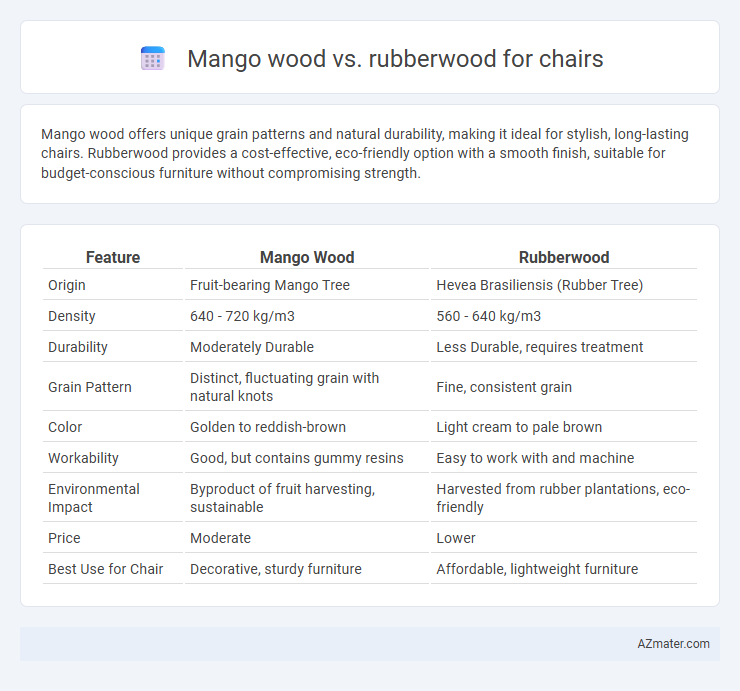Mango wood offers unique grain patterns and natural durability, making it ideal for stylish, long-lasting chairs. Rubberwood provides a cost-effective, eco-friendly option with a smooth finish, suitable for budget-conscious furniture without compromising strength.
Table of Comparison
| Feature | Mango Wood | Rubberwood |
|---|---|---|
| Origin | Fruit-bearing Mango Tree | Hevea Brasiliensis (Rubber Tree) |
| Density | 640 - 720 kg/m3 | 560 - 640 kg/m3 |
| Durability | Moderately Durable | Less Durable, requires treatment |
| Grain Pattern | Distinct, fluctuating grain with natural knots | Fine, consistent grain |
| Color | Golden to reddish-brown | Light cream to pale brown |
| Workability | Good, but contains gummy resins | Easy to work with and machine |
| Environmental Impact | Byproduct of fruit harvesting, sustainable | Harvested from rubber plantations, eco-friendly |
| Price | Moderate | Lower |
| Best Use for Chair | Decorative, sturdy furniture | Affordable, lightweight furniture |
Introduction to Mango Wood and Rubberwood
Mango wood, derived from the fast-growing mango tree, is valued for its durability, unique grain patterns, and eco-friendly sustainability, making it a popular choice for quality furniture such as chairs. Rubberwood, sourced from the Para rubber tree after latex extraction, offers a dense, stable material with a light, even texture that is resistant to warping and commonly used in affordable, sturdy chair production. Both woods provide sustainable alternatives to traditional hardwoods, with mango wood prized for its aesthetic appeal and rubberwood favored for its cost-effectiveness and environmental benefits.
Origin and Source of Mango Wood vs Rubberwood
Mango wood is sourced from the mango tree (Mangifera indica), primarily grown in India, Southeast Asia, and parts of South America, prized for its sustainability as it utilizes discarded fruit trees after their productivity declines. Rubberwood comes from the Para rubber tree (Hevea brasiliensis), mainly cultivated in Southeast Asia as a byproduct of the rubber industry when trees reach the end of latex production. Both woods are eco-friendly options, with mango wood harvested from fruit trees and rubberwood derived from plantation-grown rubber trees, making them sustainable choices for chair manufacturing.
Appearance and Grain Patterns
Mango wood features a rich golden to light brown color with natural dark streaks, creating a unique and rustic appeal for chairs. In contrast, rubberwood showcases a more uniform light yellow to pale brown tone with a subtle, straight grain pattern that offers a clean and contemporary look. Both woods provide distinct aesthetic qualities, with mango wood emphasizing warmth and character, while rubberwood delivers simplicity and modern elegance.
Durability and Strength Comparison
Mango wood and rubberwood both offer robust durability for chair construction, with mango wood being denser and harder, making it more resistant to dents and scratches compared to rubberwood. Rubberwood, while slightly softer, provides strong structural integrity and excellent shock resistance due to its tight grain pattern, which helps in maintaining stability over time. Mango wood's natural oils also enhance its resistance to pests and moisture, contributing to longer-lasting strength and durability in various climates.
Sustainability and Environmental Impact
Mango wood, sourced from harvested mango trees after fruit production declines, offers a sustainable alternative by repurposing existing resources and reducing waste. Rubberwood, derived from rubber trees at the end of their latex-producing lifecycle, promotes environmental sustainability by utilizing plantation-grown timber that would otherwise be discarded. Both woods minimize deforestation impact, but mango wood's faster growth cycle and natural resistance to pests enhance its eco-friendliness in chair manufacturing.
Workability and Crafting Suitability
Mango wood offers excellent workability with its medium density and fine grain, making it easy to carve and shape for intricate chair designs. Rubberwood, known for its uniform texture and light weight, provides superior crafting suitability due to its consistent grain and minimal warping. Both woods are sustainable choices, but Mango wood allows for more detailed craftsmanship while Rubberwood excels in mass production and durability.
Cost and Availability
Mango wood is generally more affordable than rubberwood due to its faster growth cycle and abundance in tropical regions, making it a cost-effective choice for chair manufacturing. Rubberwood, sourced from rubber trees after their latex production lifespan, tends to be pricier and less widely available outside Southeast Asia, impacting its accessibility. Both materials offer sustainable options, but mango wood's wider availability often leads to lower costs and easier procurement.
Maintenance and Long-Term Care
Mango wood chairs require regular oiling to maintain their natural luster and prevent drying or cracking, while rubberwood demands less frequent treatment due to its dense grain and natural resistance to pests. Both woods benefit from gentle cleaning with a damp cloth and avoiding prolonged exposure to moisture to prevent warping or mold growth. Over time, mango wood may show more character with its unique grain patterns, whereas rubberwood ensures consistent durability and easier upkeep for long-term chair maintenance.
Best Uses in Chair Construction
Mango wood, known for its dense grain and durability, is ideal for crafting intricate chair designs with a smooth finish and natural resistance to wear. Rubberwood offers a sustainable and cost-effective alternative with a lighter weight and uniform texture, making it suitable for mass-produced chairs that require easy maintenance. Both woods provide excellent stability, but mango wood excels in high-end, decorative chair construction while rubberwood is preferred for functional, everyday use.
Conclusion: Which Wood is Better for Chairs?
Mango wood offers superior durability, distinctive grain patterns, and natural resistance to wear, making it a preferred choice for high-quality chairs. Rubberwood is more affordable and eco-friendly but tends to be less durable and can be prone to dents and scratches over time. For chairs requiring long-term strength and aesthetic appeal, mango wood is generally the better option.

Infographic: Mango wood vs Rubberwood for Chair
 azmater.com
azmater.com